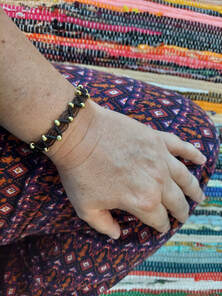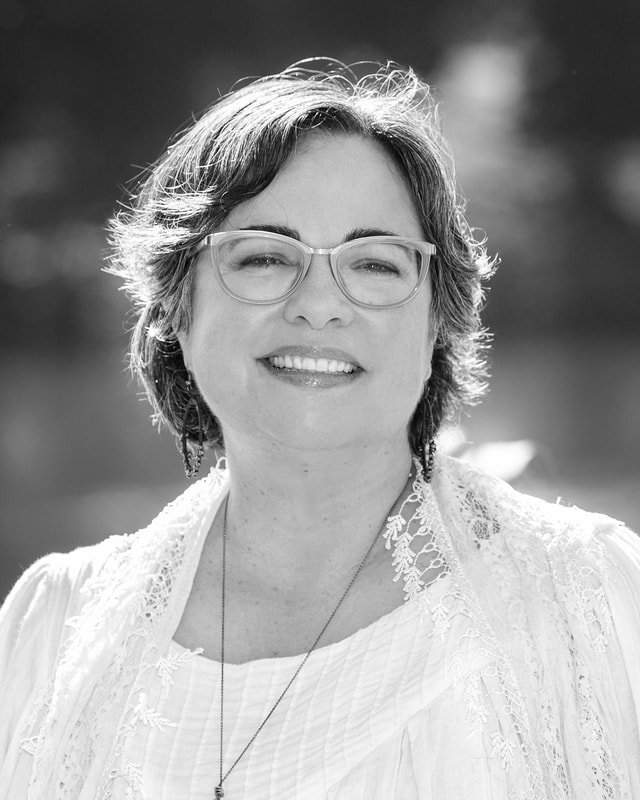|
I've been building scaffolding around writing a book: supports to give my project many chances to succeed.
The first eighteen months of starting this book involved resting, wool-gathering, reading. Writing questions to myself in a small black journal dedicated to the book. Mulling things over. An apt image would be a large, shallow collecting basket for those fragments of herbs, bits of shiny stuff and strands of half-stories. Another crucial part was taking a summer off from researching the book-- something that I could never have done in my corporate career. But I was so burned out; it was a huge relief to just be a human being and not a writer for three months. I spent hours outdoors. I painted with watercolors and swam, cooked, spent time with family and traveled. When fall came, I was rested and ready. I had to get my house in order. I gathered all the books on my topic into one area. I printed some of my notes. I taped photos of my subjects to the wall in my office. Next came the talisman. From Etsy, I bought and tied on an inexpensive thread bracelet as a reminder of my commitment to this book. I made a double square knot. Either the bracelet wears away and falls off, or the book is completed, whichever comes first. This is my own invention and I have done it for three books so far. Also in the magical realm, I remembered a lesson from writer and teacher Kate Evans and wrote a permission slip, posted on the wall, which allows me to say yes to the everything that helps me write the book, and say no to mostly everything else. You can call on ancestors and angels for help in the permission slip, too. Another author/teacher, Joan Rose Staffen, recommends writing a manifesto, an extended permission slip where you note which hours work best for you, what your rewards might be, and what you have at stake. Both methods strengthen one’s writing self. As author and journalist Cathleen Miller often told her students, “Only YOU can write this book.” Then more practical steps. I blocked out writing time during weekday mornings in my phone calendar. On the whiteboard I created an 18-month timeline, breaking the time into chunks for drafting scenes (relatively quickly, 12 weeks) and more time for revision and polishing. This schedule gives me December off for holidays and family. Also April, to take a breather before more edits. On yellow pads I listed actions to take. The lists are not necessarily in order. As composer John Cage famously said, “Begin anywhere.” This year, for the first time, I opened a large monthly calendar on paper where I briefly log in, by hand, what I accomplished that day. I created documents for chapter one, the table of contents, the introduction, the bibliography, the chapter notes. And I created a tracking sheet for elements of the book, including the index and acknowledgements. Here's a writing accelerator: I bought Ann Randolph’s Unmute Yourself writing class, 9:00 am Monday through Friday, to join anywhere from fifty to a hundred other people on Zoom while we write. This is my second go-round of structure, ritual, and fellowship. The class lasts a month and the low price is well worthwhile to jumpstart the morning writing routine. Three weeks in, I’ve completed drafting Chapter 1, and parts of Chapter 2 and the introduction. Once I’ve finalized the table of contents, I'll review the notes from the past year and tuck them into a tickler file, confining them to their chapter. The process I’m describing evolved over time. It gives me enough processes and rituals and tools to keep addressing the work, morning after morning. Each day that I log progress, I feel some satisfaction. I wrote, and the book is moving in the right direction. I hope something in this laundry list might help someone else as they think through how to attack their own next book. 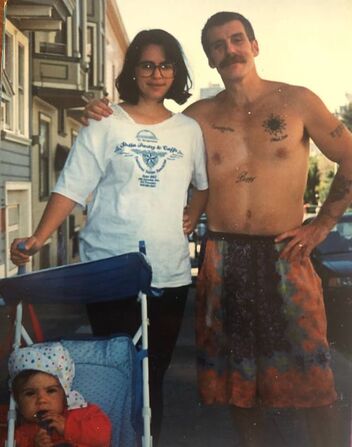 Yesterday I reviewed my log of writing, reading and art-making since January, and was pleasantly surprised. My current projects are so much in their beginning stages that everything feels loose and mysterious, and I had wondered whether much had been accomplished at all. But there it is in black and white – scores of days of generative writing, mostly essays that can feed the projects, plus several months of reading (biographies) for research, and very recently, some summery days of plein air painting and collage. My studio is a chaotic, fertile mess. I flew to Seattle to soak up a writer’s conference. I pitched a lecture about Spiritualism and historic women in the San Jose area and landed a date at the Winchester Mystery House; I reviewed Marc Zegans’ haunting book of San Francisco poems, Lyon Street, and now the review lives in the summer print edition of Rain Taxi. What an honor! And poems I wrote about my Dad were published online in the summer edition of the excellent and tender Months to Years Literary Journal. That feels like a reasonable workload for six months. I am now my own boss, and my boss gives me Fridays off. Late last fall we sadly learned of the death of my first husband, the painter, poet and cartoonist Momo. Father to my daughter and stepdaughters, Momo and I shared nearly thirteen years of art shows and escapades, first in the narrow alleyways of San Francisco’s North Beach, then in Eugene, Oregon, and finally in an outpost in pre-Google Mountain View. I’ve been reviewing those days, sifting through them. Nostalgia could come too easily – “those were the creative days.” But in fact, that’s not true. I was an active poet and performer when I met him, and had begun to paint and sculpt. When we met and married, through no real fault of his, I became a Shadow Artist, an important phrase by Julia Cameron. The spotlight was on Momo. I became his manager, curator, driver, dresser, and the one who paid the bills. I guess I needed all that experience – it grew me into a successful project manager and corporate communicator. But only after the marriage ended did I gain the energy to write books, and to create piles of collages for art shows. Some successful artistic couples collaborate to create a rich body of work – but it just didn’t work out that way for me. Now I keep learning lessons over and over about how to stay a healthy and fully creative human being. For example, the writing and art won't happen unless I arrange conditions for the flow -- a place to work, the right tools, a time carved out on my calendar. And to say yes to my current projects means saying NO to so many other attractive things, especially in this "post-pandemic" summer when theaters, concerts and fairs are newly revived, and travel beckons, and friends want to gather. No complaints about this abundance, but I'm working on balance. There's a new biography underway, another how-to book, a memoir and more. Thank goodness for all those years learning project management! Enjoy your summer. I nearly didn’t go this year – work was busy, and 2020 had already induced massive Zoom fatigue. But I was intrigued by the promise of the conference, so I registered, tested the new platform, and dipped in, and the 2021 Association of Writers and Writing Programs Conference was not just a silver lining of the pandemic for me – it turned out to be a platinum lining.
Let’s take a step back. I’ve been to two other AWP conferences. Seattle (2014) was my first, I was alone, and my adrenalin rushed the entire time. Navigating three hotels and downtown Seattle, I made it to two or three panels and a keynote, and spent two full, full days at the book fair (imagine: a football field full of tiny tables of books. And tchotchkes). At the end, I left my clothes at the hotel and packed books and magazines in my suitcase instead, tossing it into the plane’s overhead compartment and developing frozen shoulder that required months of physical therapy. Talk about memorable. I brought home better souvenirs, though. That sweet, crazy sensation of being surrounded by more than 14,000 people who loved writing. Two publishers who said they’d like to see my work. I heard Gary Snyder read. And I began to work seriously on a biography that would take seven years to complete. Then there was Tampa (2018), an excuse to visit Florida in early spring. I talked my husband into coming with me and we explored the river city at night, hearing readings in galleries and cafes. I think I saw four panels that time. We listened to George Saunders, enchanted. I had a mission to pitch my biography, but never found traction. The crowds were overwhelming and not quite as charming as the first time. Still, this time I brought home subscriptions to beautiful literary magazines, along with pins (Read Local! Today I Shall Create!) and pens and a book about how to manage the business of writing. This year, the organizers pre-recorded the sessions and those panels remained accessible for three weeks. This one move elegantly removed my greatest AWP frustration – wanting to attend simultaneous panels. Like the other years, I selected about 25 events without hope of attending them all. I was wrong. The conference lasted five days, but the recordings are still up as I write this post. I have listened to 24 panels in 12 days, most of them all the way through, and found ten more to attend next week. It’s been like an MFA on steroids. There’s an art to managing the online panels. I like to examine the chat history first, because both panelists and attendees often list interesting links and tools. I download the files that the panelists provide, sometimes pages of tips or booklists. Then, as I listen, I check out the panelist biographies and what reviewers have said about their books-- unless I’m taking notes on what they are saying. Or I stretch and do pushups while listening. I’ve thanked panelists and they’ve written back! I’ve completely filled a new notebook, and certain things I’ve learned have informed how I’m going to write this new book that has me firmly in its jaws. And because there were no plane or hotel fees, I allowed myself to buy books – like, thirty of them (something I’ve never done before): poetry, essays, craft books, novels, biographies. Books that AWP panelists and attendees collectively raved about – from independent presses when I could, and from Amazon, because budget. I also listened to conversations about helpful ways to publicize one's small or self-published book, and ways to make money in the meantime, and how to teach different groups to write. I heard from writers over fifty, and Appalachian writers, and Muslim poets, and poets who write nonfiction, nature writers, and screenwriters. . . . And I got to watch national Poet Laureate Joy Harjo’s magical jazz poetry session three times, and she’s that great, that amazing. Now books are arriving on my porch a handful at a time, a couple of new subscriptions will kick in, and I’m feeling fortified with Vitamin AWP for another few years. I didn't stay up late once, or have to find a seat in a smoky bar. When I go again in person, it will be fun, and new in a hundred different ways. But I doubt that it will top this intensive, private education -- one panel at a time, in my sweatpants, eating my own sandwiches. This was a colossal gift. 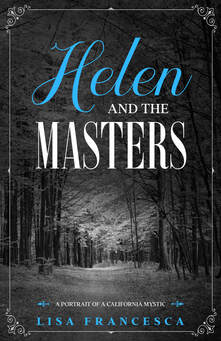 I’ve been writing one book in particular since about 2014. First, it served as my MFA Nonfiction thesis. When it was accepted by the committee, I chose to embargo its academic publication. I wanted to give this little book a chance to be published before it became fodder for future academics and scholars. But the question of who would publish it grew tough. Who would read a story about a woman in the early twentieth century who becomes a medium for interesting voices, through automatic writing? A woman who, unlike Sarah Winchester, did not become famous. And unlike Jane Roberts or Sylvia Browne, did not publish her writings for a commercial audience. My book seemed to be too much of a family story to be literature, but too lyrical to be a straight-up biography. While I hunted for publishers and agents, the entire book had to be overhauled anyway – the academic tones rinsed out, and new transitions inserted. Pieces I loved all the way to the last draft had to be ruthlessly axed, while other items from an early draft marched back in. From 2017 through early 2020, I alternately cast it down and took it back up. I hated myself when I wasn’t writing, a common writer trait. I began to bargain with my Higher Power. ‘Show me what to do,” I demanded. “Make it really obvious!” The first break in the mist was an email from my uncle, saying he’d help me publish the book for the family. I began to realize that this was an offer of real freedom – I would not have to change the book to fit the agenda or category for an agent or a publisher. Then the pandemic arrived, changing my daily routines -- no more commute, no movies, no restaurants, no gatherings. Many people talk about how they are cleaning their closets and gardening during this COVID era. I don’t have a garden and in 2020, most of my worldly goods were in storage. So I came back to the book. I kept coming back until one day, it felt done. Then a good friend decided to self-publish using an online behemoth you all know – and she told me how easy and straightforward the process was. She was right! Within two weeks I had a cover design, a formatted interior and an ISBN number. Thanks to my uncle, I was able to order about 50 copies of that little book and gift them to family members. Sending all these good people a book that I wrote about channeling spirits through automatic writing was a bit like going to a big reunion and taking my clothes off. I wanted to go into hiding for a few months until I felt safe again. But I finished the book, and I made it the very best I could. The response has been warm and positive. Writing the book grew me as a writer and as a historian, and as a member of my communities. And I am pleased to realize that, whatever good readers can find in it, by bringing their own spacious minds to interact with the page, that is a little bit of good that would not otherwise have existed in the world. That scrap of good is my legacy. Helen and the Masters: A Portrait of a California Mystic is available as a paperback on Amazon. 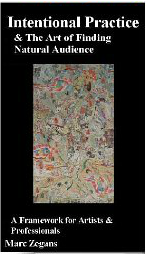 “When artists and professionals regularly accept responsibility for their actions, they shape deep, rich, and evolving pictures of who they are, pictures that permit them to act consistently with emerging notions of their authentic selves.” Intentional Practice & The Art of Finding Natural Audience: A Framework for Artists and Professionals. Marc Zegans is a poet in Santa Cruz, California who provides creative development advice to artists, musicians, actors, directors, and other creatively minded professionals such as therapists. He wrote a brilliant, very slender e-book a few years ago and put it on Amazon at such a ridiculously low price that it should already rest in the toolbox of every artist and professional. I recently re-read it and was reminded of how I want to function as an active, authentic, ethical artist and minister, and where my natural audiences might be. Based on my working session with his book and his penetrating questions, I now know exactly how I will overhaul my website and blog in the next few weeks so that they more accurately reflect who I am. If you want to know more about Marc and the many creatives and professionals he’s helped, trot on over to www.mycreativedevelopment.com. Meanwhile, here are two more of many, many gems from his book: “Your natural audience isn’t everyone you can pull into the room; it’s the group of people who have a good reason to be there.” “Often, we claim that authenticity and integrity demand distance as a rationale to cover our fear of engagement. When such claims are based in fear, there is nothing authentic about them. We are using a ploy to protect ourselves from finding out how good we really are, what we can do when we have resources, and what we will do when we don’t.” 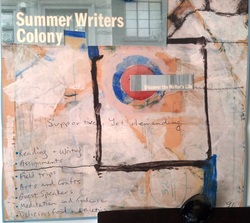 Over the past several weeks I’ve identified elements of what, to me, would make up a satisfying Writers Colony, a summer boot camp for the writer who wants to complete a project or two. We’ve touched on the obvious importance of reading and writing, and on more subtle helps from meditation. We’ve looked at writing supports such as physical exercise and hearing other writers talk about their craft. In addition to these, I recommend field trips to stimulate your brain. Not just your field work, but what Julia Cameron famously calls Artist Dates. You might poke around the shabby antique store in your neighborhood, or get a meal at a hot-dog stand shaped like an orange, or visit the bowling alley. Art museums and galleries, of course! This summer I went beachcombing in North Carolina’s Outer banks. Over several mornings I realized that gathering and sorting shells can become a profoundly insightful editing process, a metaphor learned through my hands and eyes that will inform my future work. I also mentioned arts and crafts in my first post. Don’t confine yourself to the page, the screen, the black ant trail of letters marching ever onward. Make room for fun, mess, and possibility. If you have any art materials, unearth them and make a space for them. Schedule a late afternoon, or maybe an early morning. You have no art materials? String penne noodles on a length of dental floss and wear it. Or take a page from your newspaper and scribble on it, blacking out all but some random words. Gardening is good, as are origami and sketching. We are experimenting with new ways of seeing. As I wrap up this series, I look at my two huge writing projects (one, the extroverted task of setting up a publicity strategy for The Wedding Officiant’s Guide, and the other very introspective task of figuring out how to tell the story of the next book) and I am glad to see that I accomplished something; I’ve chipped away at the mountains. Accountability really helped. My friend, Jennifer, patiently accepts an e-mail from me every Friday afternoon that lists all the micro-actions I took that week. Jennifer is under no obligation to even read what I send. I keep a sticky note on my desktop, add to my list every time I do something, and start the list fresh on Saturday. Somehow this is the accountability that I need. Have you heard the term “Bookending”? Suppose you have a task you really don’t want to face, for whatever reason. Work it out with a friend that you will call them just before the task and again just after the task. You don’t need to talk much—just check in. It really helps! Accountability requires some form of community. Ultimately, community is what differentiates a writing retreat from a session at a writing colony. Where is your community? If you don't already have it, you might find some in a writing class, a writing MFA program, a poetry group, a writer's club, a coach, or in multiple online writing spheres. I hope this Summer Writers Colony series entertained you, and in some way helped your own process. I expect to be called away from the laptop shortly as twin babies make their debut in my family. When I get back, I’ll write about weddings and my experience with publishing The Wedding Officiant’s Guide, as well as some thoughts arising from my spiritual studies. What writing tasks did you work on this summer? Back to Part 5 Now I need to read all of Lisa's blog posts 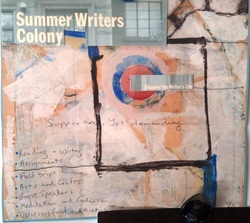 Last week I enjoyed a summer vacation and family reunion in a spectacularly large house on the Outer Banks, a place on the North Carolina coast I had not heard of. I tried new things like stalking wild mustangs, taking a group portrait on the beach, even poring through the Wright Brothers’ Memorial Museum in Kitty Hawk. In the midst of the hubbub, I did some writing. I slipped away from the breakfast table every morning around seven and took barefoot walks in the sea foam, and along the way, two essays formed themselves. Writing, after all, is why we are here in the Writers’ Colony, right? If not writing on a particular project, then doing other non-project writing that keeps us limber and juicy. Journaling, letters. Essays and poetry and little stories, all are encouraged. And to feed our brains, we read good writing. I kept far from the laptop and television on vacation, and only used my phone as a camera. Books flew naturally into that vacuum. In eight or nine days I read:
Reading de Botton and Otsuka stretch my book-structuring skills and make me want to choose finer words. Allende makes me think about writing scenes and time transitions. Sparks points out that what I saw in the Outer Bank waves were porpoises, not dolphins. And Colwin makes me want to bake gingerbread. What are you reading? And how are you working on your own writing project? Have you set yourself milestones? Here’s a list of marching orders I’ve cooked up for my new book. If you see anything you like, take it and make it work for you. Tasks for the book
Back to Part 4 Let's hit the finale! Part 6 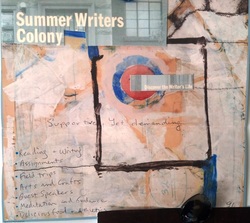 The Wharf to Wharf is an annual six-mile run/walk from Santa Cruz to Capitola. Each year, its 16,000 tickets sell out right away. Gentle coastal scenery, the ocean breezes, and support from a panoply of artistic Santa Cruzians -- all make this a special event. But better than that, better even than the T-shirt? The best part is training for the Wharf to Wharf. After all, the event is only one morning long, but training requires, for me, weeks of walking my neighborhood. Every other morning I tramp through my local suburbs, immersed in the sound of wind through the trees. I scan flights of crows, lovingly tended gardens, dappled shade. Mornings are best, before the heat is too much. There’s a fresh quality to the light, an almost golden tinge to the edges of black oaks and pepper trees. These past few weeks I’ve written about combining key elements to create a writer’s colony session in your own home, at your own pace. Part of our summer retreat has got to be exercise, if only to undo some of the damage that winter and bad habits created. Walking is my favorite -- athletics, esthetics, meditation and writing practice rolled into one. Walking makes us breathe more deeply, washing away toxins accumulated from fretting at the computer as we write. The stride sends fresh waves of oxygenated blood coursing through the brain. The nonverbal rhythm of step after step informs the internal rhythm of words. Instead of focusing on marks that inch across the screen, we can practice diffuse awareness: the breeze, a scent of sun-ripened apricot, pressure from the balls of our feet resting on cement and then pushing off again. We spend some moments lost in thought, brought back abruptly by some external stimulant: a crossing, a dog, a bee, an airplane, another walker. My body moves, my mind moves, my attention expands and contracts. All this allows new ideas, new solutions and resolutions. Walking also helps me to slowly release my writer’s tire and shake out ever-constricted shoulders. Writers have reported swimming and sweeping or raking to be similarly helpful. What physical activity keeps you sane as you write? Back to Part 3 Heck, why not Part 5 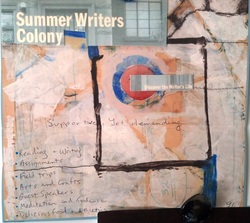 Last week we talked about how to find brilliant speakers to listen to during your stay at the Summer Writers’ Colony. Now let’s talk about listening for the most important voice of all. The arc of this summer is about discovering your writing life. Retreats are about pruning away all the non-essentials of everyday life. For writers at Yaddo, all that’s left after pruning might be a small bed, a large desk, and lunch delivered every day in a basket. But perhaps you, like me, are surrounded at home by family members, animals that need feeding, and mountains of laundry. Then it is essential to start, strengthen, and maintain a meditation practice, if you do not have one already. By meditating daily, you are creating that still, spare room in which you write. If you are starting your very first meditation practice, begin with five minutes. Lengthen your session by a minute every few days. Twenty minutes is a good session. Twenty minutes twice a day is probably optimum. You are rebooting your system. You can find eleventy-seven ways to meditate on the Web, so I won’t crowd this post with how-to. But it’s worth pointing out that meditation practices tend to fall into one of two camps. Either you watch your thoughts rise and pass (insight meditation), or you perform a technique in order to temporarily ignore your thoughts (concentration or tranquility meditation). Now, we writers think A LOT. We spend most of our time embroidering our stories—that’s how we roll. The benefit of owning a delirious writing brain is that when you give yourself a little peace and quiet, the most outrageous and wonderful ideas tend to pop up. The downside: we are more vulnerable than the average Jane to getting mired in our stories. Folks who are in recovery from various addictions are often warned, “Your mind is a dangerous neighborhood; don’t go in there alone.” But as a writer, I have to disagree — yes, it can be an dangerous place, but that's where I live and do my best work. We find our balance on the razor's edge. So you might want to spend a little time thinking about which kind of meditation you need right now. If you are stuck in something you’re writing about, try insight meditation techniques and let the thoughts come. Just don’t chase them. Keep a pad nearby and jot down any particularly gripping scene or solution, then let it go. As a writer, you are allowed to do this. And then get back to your breath. If, on the other hand, your mind is more crowded with characters than a Lower East Side turn-of-the-century tenement, by all means, use a mantram or your breath to shut off the neurojuice for a while. It’s your brain and your meditation practice. Make this divine tool work for you. Your homework this week: Start a notebook about your writing life. When are your best hours? What helps you to quickly get down to business? How do you decompress? How’s the meditation going? Leave a comment and let us know! Back to Part 2 Onward to Part 4 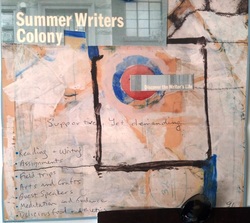 Welcome to part 2 of my Summer Writing Colony series. You can read Part 1 here. Make this year's staycation count! Today we will look at how you can bathe in wisdom from at least one brilliant speaker every day, even without a cent in your pocket. National Public Radio In my area of National Public Radio, we access an amazing weekly series of writer interviews called City Arts and Lectures. I have listened to and been inspired by writers in my car, at home, live streaming on the treadmill at the Y. But that's not the only writer-friendly program. Just today, Forum has a talk about letters between two poets. What's in your area? The New York Times The online New York Times has an Opinionator blog series called "Draft," essays on craft by exceptional writers. You can access the New York Times up to ten page views per month without paying. (I do support public radio and subscribe to news and writing outlets whenever I have the finances to do so.) TED Talks and YouTube writer profiles The online Technology, Entertainment and Design conference covers about a zillion topics. Did you know that TED has a series of talks exclusively about writing? Meanwhile YouTube has interviews with writers and poets, biographers and history detectives, and sometimes you can watch them read their work. Find the writers you love and admire and learn from them! Even Writers' Digest is on YouTube. What else can you find? Your Public Library Bring home classic writing craft books, immerse yourself in a biography about a favorite writer, or find CDs where writers and poets read their own work. OMG, Audiobooks! Help yourself write your book by checking out a few books on your subject matter. Live with them for a couple of weeks. You will get a deeper dive than online searching. And make an effort to let random chance happen. Make yourself WALK THE STACKS. Your serendipitous find may be just around the corner. Local Author Events You can learn so much about what the author wrote, how she or he wrote it, and more. You also do a service by attending, as any author would prefer to look at a group of living bodies rather than empty seats. And you never know who you will meet or what ideas will capture your mind. While you can freely attend, try if you can to bring cash for the author's book. Look up web sites for independent bookstores in your town. Barnes and Noble bookstores also have excellent author events. And check out any universities and community colleges in your area-- they often schedule visiting writer series. This week's assignment: Get thee to a literary event/reading/viewing and tell me about it. Then, schedule in more events for the rest of your Summer Colony stay. Back to Part 1 Go to Part 3 |
|
